This article relies largely or entirely on a single source .(January 2023) |
De Lek was a heerlijkheid (manor) and municipality in the Netherlands, located in the province South Holland. It is named after the Lek River.
Contents


This article relies largely or entirely on a single source .(January 2023) |
De Lek was a heerlijkheid (manor) and municipality in the Netherlands, located in the province South Holland. It is named after the Lek River.


According to the 19th-century historian Van der Aa, [1] the old Heerlijkheid van de Lek covered the villages of Lekkerkerk, Krimpen aan de Lek, Krimpen aan den IJssel, Ouderkerk aan den IJssel, Berkenwoude and Stormpolder, and possibly Nieuw-Lekkerland. This was a large area east of Rotterdam.
The first Lord of the Lek is reported to be a younger brother of Diederik II of Brederode. After his death around 1063, the heerlijkheid became first a property of the lords of Teilingen, and then of the lords of Polanen. When Engelbert I of Nassau married Johanna van Polanen van der Lekke in 1404, the possession went to the house of Nassau.
After the death of Prince Maurice of Nassau, De Lek was inherited by his illegitimate son William, who called himself Nassau-LaLecq after De Lek. After his death it went to his younger brother, Louis of Nassau, Lord of De Lek and Beverweerd. The last descendant of this family was Jan Floris van Nassau-Lalecq, who died in 1824.
Around 1800, the manorial system in the Netherlands was abolished. The villages in the heerlijkheid De Lek became independent municipalities, but small part of the heerlijkheid was excluded and remained a separate municipality, "De Lek". It was only a municipality in name, having no mayor or other municipal services. The municipality covered the river Lek between Ammerstol and Krimpen aan den IJssel, and some islands and surrounding lands. Its area was 5.99 km2, of which 1.24 km2 was land, and it contained several small fisherman's huts and boathouses, but it had no inhabitants. [1] In 1847, the territory of De Lek was divided among the surrounding municipalities.

Krimpen aan den IJssel is a town and municipality in the western Netherlands, in the province of South Holland. The municipality had a population of 29,410 in 2021, and covers an area of 8.95 km2 (3.46 sq mi) of which 1.26 km2 (0.49 sq mi) is water.
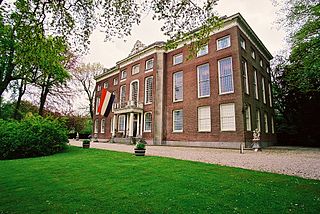
Ridderkerk is a town and municipality in the western Netherlands, in the province of South Holland. The municipality had a population of 46,671 in 2021 and covers an area of 25.26 km2 (9.75 sq mi) of which 1.54 km2 (0.59 sq mi) is covered by water.

The Hollandse or Hollandsche IJssel is a branch of the Rhine delta that flows westward from Nieuwegein on river Lek through IJsselstein, Gouda and Capelle aan den IJssel to Krimpen aan den IJssel, where it ends in the Nieuwe Maas. Another branch called Enge IJssel flows southwest from Nieuwegein. The name IJssel is thought to derive from the Germanic i sala, meaning "dark water". Originally, the Hollandse IJssel forked off from river Lek at Nieuwegein, but the connection was cut off with the Hollandse IJssel nowadays only draining the surrounding pastures.

Lekkerkerk is a town and former municipality on the Lek River, now part of the municipality of Krimpenerwaard, South Holland province, the Netherlands. Since 1 January 1985 Lekkerkerk is no longer an independent municipality.

Van der Giessen de Noord was a shipbuilding company that mainly built ferries, located in Krimpen aan den IJssel, a town in the western Netherlands. The yard was especially suited to the construction of large vessels due to its developed undercover facilities.

Schalkwijk is a small village in the Dutch province of Utrecht. It consists of a small village centre on the railway line between Utrecht and 's-Hertogenbosch and a 5 km long ribbon of farms along the small channel Schalkwijksche Wetering.

Heeswijk Castle is a moated castle near Heeswijk in the Dutch province of North Brabant.
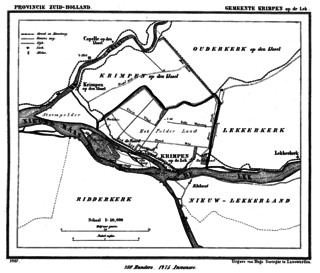
Krimpen aan de Lek is a village on the Lek River in the municipality of Krimpenerwaard, province of South Holland, the Netherlands. It had 6,607 inhabitants in 2008.
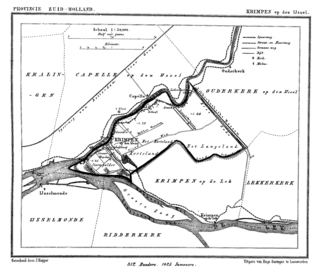
Stormpolder is a polder and a hamlet in the Dutch province of South Holland. It is located about 7 km east of the center of Rotterdam, in the municipality of Krimpen aan den IJssel. It lies between the Nieuwe Maas and Hollandsche IJssel rivers.

Krimpenerwaard is a municipality, a region and a former water board of the Netherlands. It is a rural area located in the east of the province of South Holland, just south of Gouda and east of the Rotterdam conurbation. It is bordered on the north by the river Hollandse IJssel, on the south by the river Lek and on the east by the stream Vlist.

Rijnmond is the conurbation surrounding the city of Rotterdam in the Netherlands. Another term used in this context is Stadsregio Rotterdam. Located on the Rhine–Meuse–Scheldt delta, the region has a combined population of 1,181,289 as of 2021.
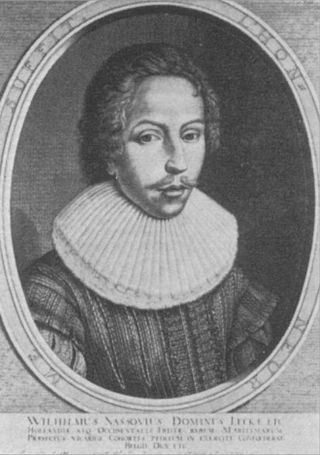
Willem van Nassau, Lord of De Lek was a Dutch soldier from 1620 until 1627. He was the illegitimate son of stadholder Maurice of Nassau, Prince of Orange and his mistress Margaretha van Mechelen. Like their other illegitimate children, he was recognized with the surname Nassau-LaLecq. He went by the title Rijksgraaf van Nassau-LaLecq" and was also popularly known in French as the "Chevalier de Nassau". After 1625, he was granted lands and the title Lord of De Lek. He received his heerlijkheid of De Lek as a bequest from his father to him and his descendants. His brother Lodewijk van Nassau had the title "Lord of Beverweerd and Odijk".
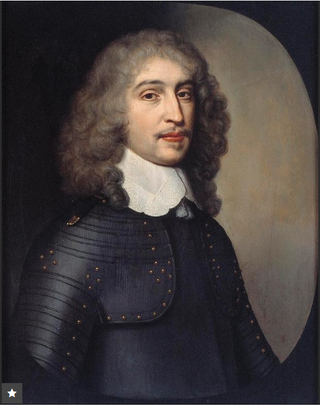
Louis of Nassau, Lord of De Lek and Beverweerd was a Dutch soldier. He was the illegitimate son of Margaretha van Mechelen and Maurice, Prince of Orange, and so a collateral member of the House of Orange-Nassau. He was a Lord of the heerlijkheid van De Lek, as well as the Beverweerd Castle and its heerlijkheid from his father.

Count John IV of Nassau-Siegen, German: Johann IV. Graf von Nassau-Siegen, official titles: Graf zu Nassau, Vianden und Diez, Herr zu Breda, was since 1442 Count of Nassau-Siegen, of Vianden and of half Diez, and Lord of Breda and of the Lek. He descended from the Ottonian Line of the House of Nassau.

Johanna van Polanen was a Dutch noblewoman. She was the daughter of John III of Polanen, Lord of Breda, and his wife, Odilia of Salm. The House of Polanen was a side branch of the still existing House of Wassenaer.

Van Polanen was a noble family that played an important role in the Netherlands during the Middle Ages. The impact of the family transcended its dissolution in the 15th century as the House of Nassau gained the vast properties of the House of Polanen in 1403 through marriage. The titles such as baron of Breda and lord of Polanen remain amongst the titles of the monarch of the Netherlands until today.

John I, Lord of Polanen was Lord of Polanen, and Lord of De Lek.
Krimpen may refer to:

Philips I, Lord of Polanen became Lord of Polanen in 1345. He later became Lord of Capelle, Nieuwerkerk, and Uyterlier. Philips was an important commander during the Hook and Cod wars.